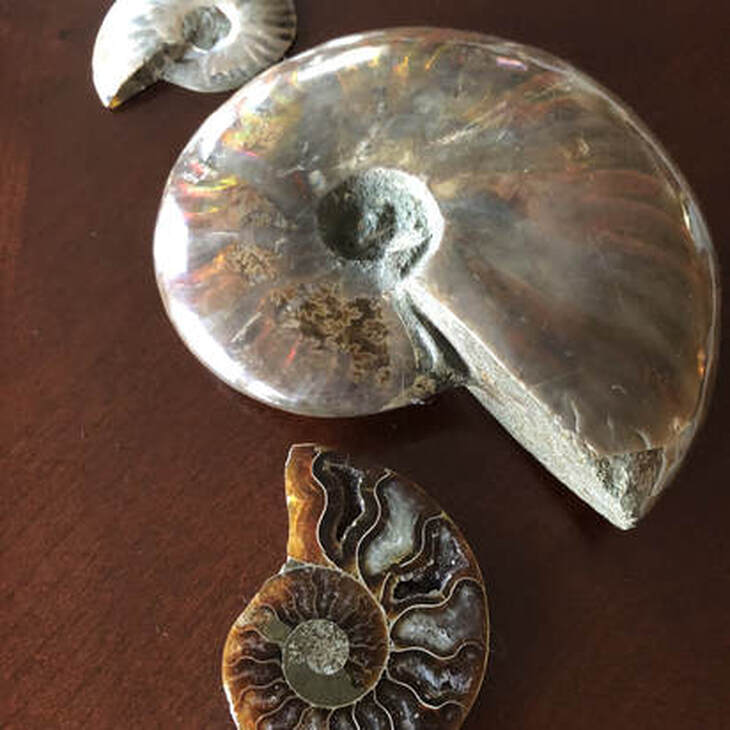|
Here are three different sizes of ammonite, which are fossilized cephalopods from 240 to about 65 million years ago. The large ammonite is opalized, and you can see the flashes of orange light around its edges. As usual, my photography hardly does it justice. Under lights, it sparkles and shines, but this photo was taken with natural morning sunlight coming in my window so there's only a hint of how spectacular it truly is.
The small ammonite on the bottom was sliced in half and polished so you can see the interior chambers that have, over millions of years, grown bits of druzy quartz in them. The opalization of the shells occurs as minerals (mostly aragonite) replace organic materials in the shells. As you can see with closer inspection of the large fossil, the opalized layer is a coating and doesn't go throughout the whole stone. When ammonites are opalized like this, the opalized coating is called ammolite, a trade name for the opalized layer when it is is cut from the fossilized shells and polished to gemstone quality. Ammolite has a trigonal crystalline lattice. According to the GIA, in order for an ammonite to become ammolite, it must be quickly buried, have no oxygen reach it, and for millions of years it needs to be safe from excessive pressure and heat. Like other fossils, ammonites are believed to contain powerful Earth energies so they are grounding. The spirals of an ammonite are like a nautilus and represent the unfolding of a spiritual path or spiritual awakening. They also promote positive vibration. If you love fossils, ammonites are a great point of entry as there are tons of varieties and you can find them fairly inexpensively for some of the smaller, more common specimens. If you buy them retail, two small polished ammonites here are about $20 each (for both halves of the fossil), and the larger ammonite is around $70, so they are a reasonably affordable entree to fossil collecting.
0 Comments
Leave a Reply. |
Categories
All
Archives
December 2022
|
AUTHOR KAREN FRAZIER
- Home
-
Books
- Angel Numbers for Beginners
- Avalanche of Spirits
- Chakra Crystals
- Complete Reiki
- Crystal Alchemist
- Crystals for Beginners
- Crystals for Healing
- Dancing with the Afterlife
- Dream Interpretation Handbook
- Essential Crystal Meditation
- Higher Vibes Toolbox
- Introduction to Crystal Grids
- Little Book of Energy Healing Techniques
- Noisy Ghosts
- Reiki Healing for Beginners
- Transform Your Life with Alchemy
- Ultimate Guide to Psychic Ability
- Usui Ryoho Reiki Manual
- Cookbooks
- Other Books
- Classes
- Connect
- Meditate

 RSS Feed
RSS Feed
